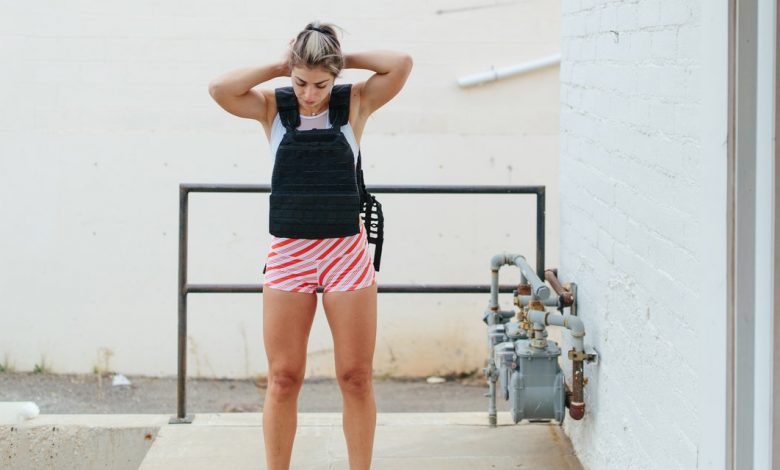How a Weighted Vest Can Amp Up Your Walks—And How to Start Using One

The humble walk has gained a trendy new accessory: a weighted vest. Historically used by CrossFitters and soldiers-in-training, these devices strap right on to your chest to add—you guessed it—extra weight. And recently, everyone from JoJo Siwa to everyday fitfluencers seems to be talking about how using a weighted vest for walking can max out the benefits of your daily steps
But does slipping a few extra pounds onto your torso really make your walks all that much better? Well, this is one TikTok trend that fitness experts say is pretty damn safe—and comes with some legit benefits.
A weighted vest can crank up the intensity of your walk, fire up different muscles, and boost balance and posture.
Walking with a weight vest is much like wearing a rucksack (a weighted backpack), except that a vest more evenly distributes the weight between your chest and back, rather than putting it all behind you. Either way, you’ll elevate your morning constitutional in a few ways. “It’s upping the intensity of your walking game,” exercise physiologist Rachelle Reed, PhD, tells SELF. She explains that walking with a weighted vest could help to improve your aerobic fitness by increasing the challenge for your heart and lungs while also strengthening your muscles and bones more than your typical low-key stroll would.
In fact, one small 2006 study found that the bone health benefits of walking with a weighted vest were similar to what you could get out of jogging (at least when the vest was as heavy as 20% of your body weight). Another earlier study that followed older women over five years found that those who regularly wore weight vests (and also did jumping exercises separately) maintained their bone density in their hips, while those who didn’t experienced a decrease over time.
Schlepping around that extra weight puts more load on all the normal muscles that help you walk, like your glutes, hamstrings, quads, calves, and core. And thanks to the vest’s positioning, your shoulders and traps will also work extra, too—so when you first start using one, those muscles might actually feel a little sore to the touch, Dr. Reed says.
This challenge to your core can have some added perks for your posture. “It’s going to force you to use better form for you to carry that load over time,” Dr. Reed points out, since those postural muscles have to fire up to hold the extra weight without letting you tip over. Steve Stonehouse, NASM-CPT, director of training and experience for Body Fit Training, tells SELF that after getting his body used to supporting that extra weight, his posture automatically improves after he takes it off.
He adds that the increased load also challenges your balance and coordination. “If I’m on a trail and I’ve got to walk over a rock,” he says, “having to balance that additional weight, my motor skills have to work a little differently.”
In some ways, a weighted vest is also a practical choice.
Of course, a weighted vest isn’t the only way to upgrade your walk from a “light” to “moderate” workout. You could always just pick up your pace or head for the hills to get your heart pumping faster without having to invest in extra gear. But, as Dr. Reed points out, unless you’re on a treadmill, it can be tough to keep variables like incline and speed consistent—hills come and go, and so does our effort level unless we’re super diligent about it. “Using a weighted vest, which is this constant additional load, might be a more approachable way to up the intensity while you’re outside,” she says.
Stonehouse adds that it’s also a pretty safe strategy. A 2020 study on CrossFitters found weighted vests can increase the challenge of your walk without messing with your gait—which could leave you more prone to injury. Basically, this suggests it’s relatively low-risk.
Just be strategic about strapping in.
Convinced to give a weighted vest a go? Just like any new fitness regimen, you’ll want to work into it. “It’s something you’re going to have to practice,” Dr. Reed says. “Apply the principles of progressing slowly over time and allowing your body to adapt.” Even if you can normally knock out a 30-minute walk like it’s nothing, you might need to slow down your pace at first or shorten your route until you’re used to handling the extra load. Stonehouse suggests starting with no more than 10% of your body weight at first. If you get an adjustable vest that lets you change up the weight (which both Stonehouse and Dr. Reed recommend), you can gradually build up to heavier loads over time.
Once you get comfortable with walking in the vest, Stonehouse says you can also try using it for strength exercises like push-ups and squats, if you want to. A vest can be an easier way to amp up bodyweight exercises than adding dumbbells because the weight is evenly distributed and, if you struggle with grip strength, there’s nothing you have to hold onto. “You’re not having to think about that,” he says.
However, before sporting a vest for any kind of activity, Dr. Reed suggests checking with your healthcare provider first if you’re recovering from an injury or have any kind of physical limitation that complicates walking. Those with balance issues may want to be careful, too, since the extra weight can increase instability, she adds. Stonehouse also says that anyone with vertebrae conditions or who’s had something like spinal fusion surgery should steer clear altogether since weight vests put extra pressure on the spine. And if you’re pregnant, maybe skip it for now, since “you want to be mindful of carrying extra weight or stress on the midsection,” Dr. Reed says.
So should you try using a weighted vest for walking?
One of the things many people love about their walks is the simplicity—all you need is to lace up some good walking shoes and head out the door. A weighted vest obviously adds one extra step to the process. Yet Stonehouse points out that it’s still a very easy solution for those of us who might not otherwise work much activity into our day or get intimidated by complex fitness routines. “A lot of exercise equipment can be daunting, sometimes complicated,” he says. “The beauty in the weighted vest is, look, nobody’s going to say, ‘I don’t know how to use it.’ “
Really, the biggest benefit might be the fact that it’s simply another way to make you actually want to keep showing up for that daily walk. One thing the researchers of that five-year bone density study pointed out was just how committed the women stayed to the program—a rare feat in long-term research. “If using a weighted vest mixes things up just enough for you to stay engaged, excited, challenged,” Dr. Reed says, “I’m all for it.”
Related:
- Does Adding Wrist Weights to Your Walk Really Give You a Better Workout?
- Does Using a Mini-Stepper ‘Count’ as Working Out?
- What Is Zone 2 Cardio, and Does It Live Up to All the Hype?
Get more of SELF’s great fitness coverage delivered right to your inbox—for free.



